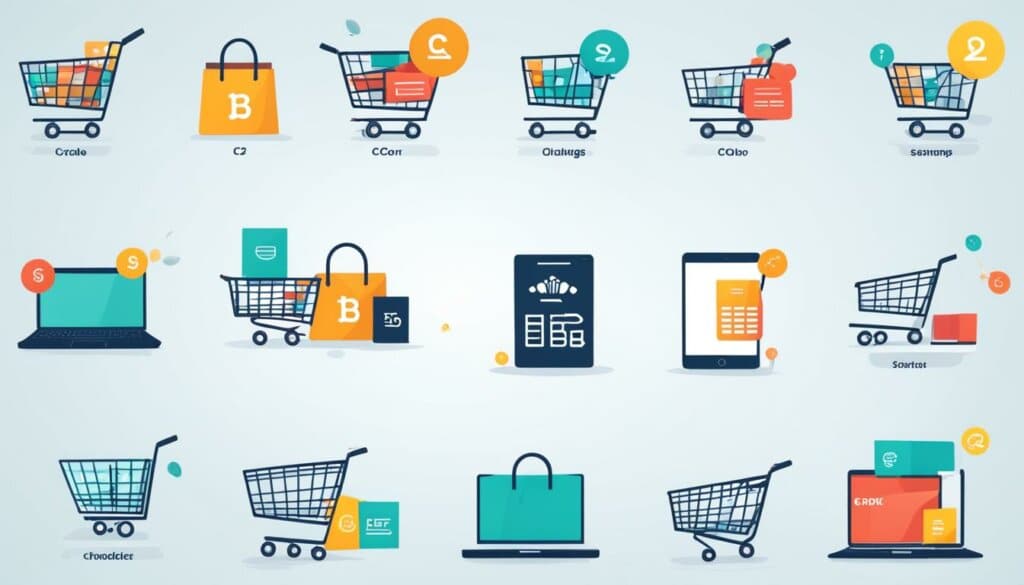Table of Contents
E-commerce business, also known as online trading, has become a booming industry with immense growth opportunities. In this digital era, more and more consumers are embracing the convenience of shopping online, making it essential for businesses to establish a strong online presence.
E-commerce entails the buying and selling of goods and services online, utilizing platforms such as websites, social media, and online marketplaces. This form of trade encompasses various functions, including online shopping, electronic payments, online auctions, and internet banking.
The e-commerce market is projected to reach a staggering $8 trillion by 2026, reflecting its tremendous growth potential. With the proliferation of internet access and the increasing reliance on digital transactions, entrepreneurs and established businesses alike are plunging into the world of e-commerce to tap into this vast market.
Stay tuned to discover how e-commerce works, explore different business models, learn about revenue generation, and understand the benefits and challenges associated with this dynamic industry.
How Does Ecommerce Work?
After a customer makes a purchase, the online retailer delivers the order through shipping, store pickup, or digital delivery for digital products. Ecommerce transactions happen on various devices and platforms, using different payment methods like credit cards, digital wallets, and buy now, pay later services. Integration with payment processors and payment gateways handles the financial transactions between businesses and customers.
When a customer completes an ecommerce transaction, the retailer takes several steps to fulfill the order. For physical products, the retailer packages the items and arranges for shipping through postal services such as Royal Mail, DPD, or UPS. The package is then shipped to the customer’s address, either domestically or internationally, depending on the retailer’s shipping capabilities.
For digital products, such as e-books, software, or online courses, the retailer typically provides a download link or access code to the customer after the purchase is confirmed. This allows the customer to immediately access and enjoy the digital product without any physical delivery necessary.
Payment methods play a crucial role in the ecommerce process. Online retailers offer various payment options to cater to different customer preferences and needs. Common payment methods include:
- Credit cards: Customers can securely enter their credit card details during the checkout process to complete the transaction.
- Digital wallets: Popular digital wallet services like PayPal, Apple Pay, and Google Pay allow customers to store their payment information and make quick and convenient purchases with just a few clicks or taps.
- Buy now, pay later services: These services, such as Klarna and Afterpay, allow customers to split their purchases into manageable installment payments over time.
Online retailers integrate with payment processors and payment gateways to facilitate the secure transfer of funds from customers to businesses. Payment processors handle the encryption and authorization of payment transactions, while payment gateways act as the intermediary between the online retailer’s website or app and the customer’s chosen payment method.
Ensuring secure and efficient ecommerce transactions is crucial for both businesses and customers. Retailers implement strict security measures, including SSL encryption, to protect sensitive customer data such as credit card information and personal details. Additionally, they comply with industry standards and regulations to ensure a safe and trustworthy shopping experience for all parties involved.
“Ecommerce transactions happen on various devices and platforms, using different payment methods like credit cards, digital wallets, and buy now, pay later services.”
By leveraging these technologies and strategies, ecommerce businesses can provide a seamless shopping experience for customers while expanding their reach and driving growth in the digital marketplace.
Types of Ecommerce Businesses Explained
When it comes to ecommerce, there are various business models that companies and individuals can adopt. Understanding these models is crucial for those looking to venture into the world of online trading. Below, we outline the different types of ecommerce businesses and their unique characteristics.
B2C: Business to Consumer
The B2C model involves businesses selling goods or services directly to individual consumers. This is the most common form of ecommerce, where companies cater to the needs and preferences of individual customers. Examples of B2C businesses include popular online retailers like Amazon and eBay.
B2B: Business to Business
In the B2B model, businesses sell products or services to other businesses. This type of ecommerce is prevalent in industries where companies rely on each other for supplies or specialized services. B2B ecommerce platforms such as Alibaba and Thomasnet connect businesses looking to source products or services from suppliers.
C2C: Consumer to Consumer
C2C ecommerce involves individuals selling goods or services directly to other individuals. This type of model facilitates peer-to-peer transactions, where consumers can buy and sell used items or provide services to others. Popular C2C platforms include eBay, Etsy, and Poshmark.
C2B: Consumer to Business
In the C2B model, individuals sell their products or services to businesses. This model is commonly seen in freelancing platforms where individuals offer their skills or expertise to companies seeking specific services. Websites like Upwork and Fiverr provide platforms for C2B transactions.
D2C: Direct to Consumer
The D2C model involves businesses selling products directly to end customers without intermediaries. This allows brands to have direct control over the customer experience and build stronger connections with their target audience. D2C brands often sell their products online through their own websites or platforms like Shopify.
“Understanding the various ecommerce models is essential for businesses to choose the most suitable approach for their target audience and goals.”-Industry Expert
By identifying which ecommerce model aligns with their objectives, businesses and individuals can make informed decisions regarding their online trading ventures.

In the next section, we will explore the revenue models employed by ecommerce businesses to generate income and sustain their operations.
5 Ecommerce Revenue Models
Ecommerce businesses have several revenue models to generate income. Each model offers unique opportunities for monetization. Let’s explore the five main revenue models in the ecommerce industry:
Sales Model
The sales model involves selling products and services for a profit. Ecommerce businesses can showcase their offerings on their website or online marketplaces, attracting customers to make purchases. This model is particularly popular among retail businesses that focus on selling physical products.
Subscription Model
The subscription model allows businesses to generate recurring revenue by offering subscriptions to products or services. Subscribers typically pay a fixed amount on a regular basis to access exclusive content, receive regular deliveries, or enjoy special privileges. Companies like Netflix and Spotify successfully implement this revenue model in the digital content industry.
Advertising Model
With the advertising model, ecommerce businesses can generate revenue by entering advertising deals with other businesses. By displaying advertisements on their website or platform, businesses earn income based on the number of impressions, clicks, or conversions generated from the ads. Google Ads and Facebook Ads are popular advertising platforms used by ecommerce businesses to monetize their online presence.
Affiliate Model
The affiliate model enables businesses to earn commission by promoting and selling other businesses’ products. Ecommerce businesses can partner with affiliate programs and promote products through their website, blog, or social media platforms. When a customer makes a purchase through the business’ unique affiliate link, the business earns a commission. Amazon’s affiliate program, Amazon Associates, is one of the most well-known examples of this model.
Transaction Fee Model
The transaction fee model allows ecommerce businesses to earn revenue by charging a fee on each sale processed through their platform. This model is common among online marketplaces that connect buyers and sellers. The platform facilitates the transaction and charges a fee or a percentage of the transaction value for providing the service. For example, eBay charges sellers a listing fee and a final value fee on each sale made through its platform.
By leveraging these revenue models, ecommerce businesses can diversify their income streams and maximize their earning potential in the competitive online market.
| Revenue Model | Description | Examples |
|---|---|---|
| Sales Model | Selling products and services for profit. | Online retailers like Amazon and ASOS. |
| Subscription Model | Offering recurring revenue through subscriptions to products or services. | Streaming services like Netflix and Spotify. |
| Advertising Model | Generating revenue through advertising deals with other businesses. | Google Ads and Facebook Ads. |
| Affiliate Model | Earning commission by promoting and selling other businesses’ products. | Amazon Associates and ClickBank. |
| Transaction Fee Model | Earning revenue by charging a fee on each sale processed. | Online marketplaces like eBay and Etsy. |
The Benefits of Ecommerce Businesses
Ecommerce businesses offer several benefits that make them a popular choice for both consumers and entrepreneurs.
Convenient Shopping
One of the key advantages of ecommerce is the convenience it offers to shoppers. With online stores, customers can browse and purchase products from anywhere, at any time. Whether they’re at home, at work, or on the go, ecommerce allows customers to shop at their own convenience, avoiding the need to visit physical stores or adhere to fixed business hours.
Global Reach
Ecommerce provides businesses with the opportunity to reach customers worldwide. Without the limitations of a brick-and-mortar store, online businesses can target and sell to customers in different countries and regions. This global reach opens up new growth opportunities and allows businesses to tap into diverse markets with varying customer preferences and demands.
Brand Building
Establishing and growing a brand presence is crucial for businesses, and ecommerce offers numerous brand building opportunities. Through online platforms, businesses can showcase their products, engage with customers through social media and content marketing, and build a strong online identity. This visibility and interaction contribute to brand recognition, loyalty, and customer trust.
Cost Savings
Running an ecommerce business can lead to significant cost savings compared to traditional retail models. Online stores eliminate the need for expensive physical store spaces and associated expenses like rent, utilities, and in-store staff. Additionally, ecommerce businesses can optimize inventory management, reduce overhead costs, and streamline operations, leading to further cost savings.
| Benefits | Description |
|---|---|
| Convenient Shopping | Allows customers to shop from anywhere, at any time |
| Global Reach | Enables businesses to reach customers worldwide |
| Brand Building | Provides opportunities for online presence and marketing efforts to establish and grow a brand |
| Cost Savings | Saves on administrative expenses and physical store maintenance costs |
The Challenges of Ecommerce Businesses
Ecommerce businesses face various challenges that can impact their success and growth. These challenges include intense competition, the need for brand building, limited control over the online store’s look and feel, and reliance on social media platforms.
Intense Competition
One of the significant challenges for ecommerce businesses is the intense competition from other online sellers. With the increasing popularity of online shopping, more businesses are entering the market, making it more challenging for new and existing players to stand out. The competition requires ecommerce businesses to be innovative, offer unique products or services, and provide exceptional customer experiences to gain a competitive edge.
Building a Brand Presence
Building a strong brand presence is crucial for ecommerce businesses to establish credibility, trust, and recognition in a crowded market. However, organic brand building can be a time-consuming process that requires consistent efforts in marketing, content creation, and customer engagement. Ecommerce businesses need to invest in brand-building strategies, such as social media marketing, influencer collaborations, and search engine optimization, to create a distinct identity and connect with their target audience.
Limited Control Over Online Store
Ecommerce businesses often rely on marketplace platforms to host their online stores. While these platforms offer convenience and access to a large customer base, they also come with limitations. Businesses have limited control over the look and feel of their online stores, as they need to conform to the platform’s design templates and guidelines. This limitation can hinder the brand’s ability to showcase its unique identity and create a personalized shopping experience for customers.
Platform Reliance and the Risk of Losing Access
Many ecommerce businesses heavily rely on social media platforms to reach and engage with their target audience. However, this reliance can be risky, as social media platforms can change their algorithms or policies, affecting businesses’ organic reach and visibility. A sudden change in algorithm or policy can result in a significant drop in reach and engagement, potentially impacting sales and brand exposure. Ecommerce businesses need to diversify their marketing channels and establish a strong online presence beyond social media platforms to mitigate this risk.
“The challenges faced by ecommerce businesses highlight the dynamic nature of the industry and the need for strategic adaptations to stay competitive and build a strong brand presence.”
| Challenges | Impact |
|---|---|
| Intense competition | Requires businesses to be innovative and offer unique products or services |
| Building a brand presence | Establishes credibility, trust, and recognition in a crowded market |
| Limited control over online store | Hinders the ability to showcase a unique identity and create a personalized shopping experience |
| Platform reliance and the risk of losing access | Risk of sudden drops in reach and engagement due to algorithm or policy changes |

Top Ecommerce Trends and Statistics
The ecommerce industry is continuously evolving, and staying updated with the latest trends and statistics is crucial for businesses operating in this digital landscape. Here are some noteworthy insights:
Projected global retail ecommerce sales to reach 22% of total retail sales by 2023.
As consumers increasingly turn to online shopping, the ecommerce market is expected to grow rapidly in the coming years. By 2023, it is projected that ecommerce sales will account for approximately 22% of total retail sales globally. This highlights the immense growth opportunities available in the ecommerce sector.
Digital wallets expected to account for over half of ecommerce payment volumes by 2024.
With the rise of digital payments, digital wallets are gaining popularity among consumers. It is anticipated that by 2024, more than half of ecommerce payment volumes will be conducted through digital wallets. This shift towards convenient and secure payment methods underscores the importance for ecommerce businesses to provide multiple payment options to cater to varying customer preferences.
Amazon projected to account for 39.5% of all US retail ecommerce sales in 2022.
Amazon, the global ecommerce giant, continues to dominate the US retail ecommerce market. In 2022, it is projected that Amazon will hold a significant market share of 39.5% of all US retail ecommerce sales. This further solidifies Amazon’s position as a key player in the ecommerce industry and highlights the importance of businesses considering Amazon as a platform to expand their online presence.
Starting an Ecommerce Business: 8 Steps to Launching an Online Store
Starting an ecommerce business can be an exciting and rewarding venture. With the right step-by-step guide, you can launch your own online store and tap into the vast potential of the digital marketplace. Here are eight essential steps to get you started:
1. Identify your niche and target market
The first step is to identify a specific niche that aligns with your interests and expertise. Conduct research to understand your target market’s needs, preferences, and pain points. This will help you tailor your offerings and stand out from the competition.
2. Conduct market research and competitor analysis
Thorough market research is crucial to validate your business idea and understand the competitive landscape. Identify your key competitors, analyze their strengths and weaknesses, and identify opportunities to differentiate yourself in the market.
3. Develop a business plan and define your brand
A well-crafted business plan acts as a roadmap for your ecommerce business. Define your brand identity, including your brand name, logo, and brand story. Clarify your value proposition and unique selling points to attract and retain customers.
4. Choose an ecommerce platform and set up your online store
Selecting the right ecommerce platform is vital for seamless operations and a user-friendly experience. Consider factors such as ease of use, scalability, available features, and pricing. Set up your online store, customize its design, and optimize its functionality to provide a smooth shopping experience.
5. Source or create your products/services
Determine the products or services you will offer in your online store. Research suppliers, negotiate prices, and establish reliable sourcing channels. If you offer digital products or services, create high-quality content and ensure secure delivery.
6. Implement marketing and advertising strategies
Develop a comprehensive marketing and advertising plan to drive traffic to your online store. Leverage strategies such as search engine optimization (SEO), social media marketing, content marketing, email marketing, and influencer partnerships to raise awareness and generate sales.
7. Set up secure payment systems and shipping options
Ensure the security of your customers’ payments by setting up secure and reliable payment systems. Explore various options like credit card processors, digital wallets, and alternative payment methods. Additionally, establish efficient shipping and delivery options to provide a seamless post-purchase experience.
8. Launch your online store and continuously monitor and optimize your business
Once everything is in place, it’s time to launch your online store. Promote your launch across different channels, engage with your audience, and continuously monitor your business metrics. Analyze customer feedback, track sales and traffic data, and make data-driven optimizations to maximize your success.
By following these eight steps, you can confidently start and grow your ecommerce business. Remember that success requires ongoing effort, adaptation, and a customer-centric approach. Good luck with your ecommerce journey!
FAQ
What is an ecommerce business?
An ecommerce business refers to buying and selling goods or services online. It involves transactions that take place on websites, social media platforms, or online marketplaces.
How does ecommerce work?
After a customer makes a purchase, the online retailer delivers the order through shipping, store pickup, or digital delivery for digital products. Ecommerce transactions happen on various devices and platforms, using different payment methods like credit cards, digital wallets, and buy now, pay later services.
What are the types of ecommerce businesses?
There are different types of ecommerce businesses, including business to consumer (B2C), business to business (B2B), consumer to consumer (C2C), consumer to business (C2B), and direct to consumer (D2C).
What are the revenue models for ecommerce businesses?
Ecommerce businesses can generate revenue through various models, including sales model, subscription model, advertising model, affiliate model, and transaction fee model.
What are the benefits of ecommerce businesses?
Ecommerce businesses offer several benefits, including convenient shopping for customers, global reach, brand building opportunities, and cost savings in terms of administrative expenses and physical store maintenance.
What challenges do ecommerce businesses face?
Ecommerce businesses face challenges such as intense competition, building a brand presence, limited control over the look and feel of the online store in marketplace platforms, and dependence on social media platforms.
What are some notable trends and statistics in the ecommerce industry?
Noteworthy trends and statistics in the ecommerce industry include the projected global retail ecommerce sales reaching 22% of total retail sales by 2023, digital wallets expected to account for over half of ecommerce payment volumes by 2024, and Amazon projected to account for 39.5% of all US retail ecommerce sales in 2022.
What are the steps to starting an ecommerce business?
The key steps to starting an ecommerce business include identifying your niche and target market, conducting market research and competitor analysis, developing a business plan and defining your brand, choosing an ecommerce platform and setting up your online store, sourcing or creating your products/services, implementing marketing and advertising strategies, setting up secure payment systems and shipping options, and launching your online store and continuously monitoring and optimizing your business.













